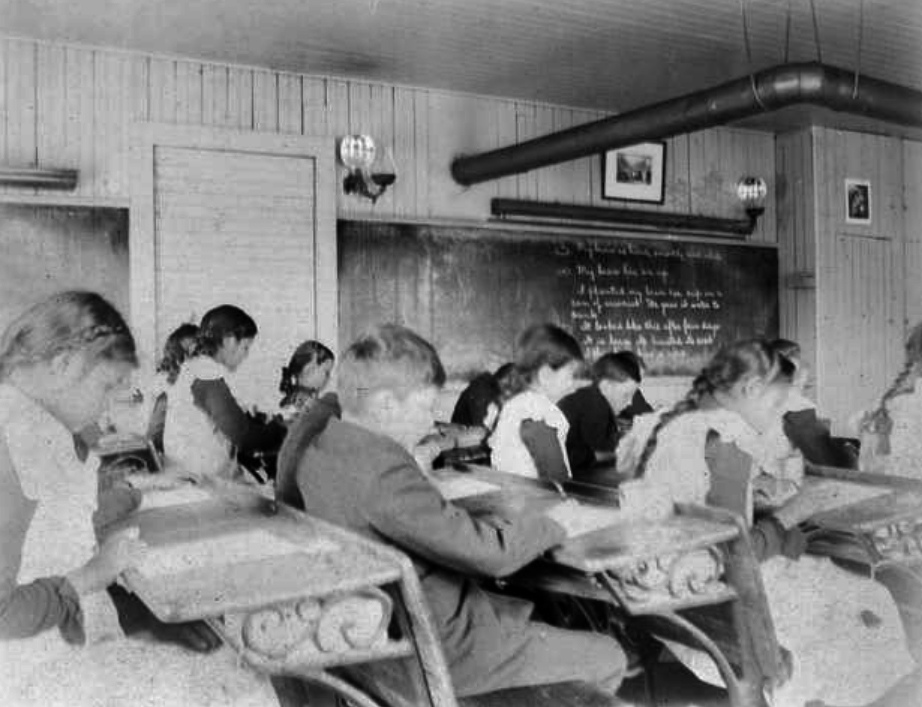
Much of what is known of Native American culture in non-Native communities is what has been romanticized in movies, books, and other forms of media which usually depicts the wise older Native American man in ceremonial garb telling stories of animals or of an Indian princess or warrior dancing during a Pow Wow. People would probably be surprised to see how people on a reservation actually live their day to day lives. Eventually, this will be what future Native American children will know of their culture. Sadly much culture had been lost during the years of the early boarding schools as children were separated from their families, homes, culture, and language, suffering years of abuse while losing the traditions and values that are so important to the Native American community. This caused a generational gap in the passing down of Native American culture which is still evident in today’s youth especially as more of the pre-boarding school generation is beginning to die off. Another factor contributing to the decrease in cultural identity is the movement from on-reservation school to off-reservation, public schools due to better funding or programs.
Therefore attention needs to be directed to off-reservation schools and how to create a more accepting environment for these Indian children which can both better their education as well as preserving their cultural heritage. I suggest that training programs be developed to instruct teachers on better ways to present information to their Native American students such as in the form of group projects where individual success helps the overall success of the group. The formation of after school programs as well as involvement in team sports have shown to also improve student performance in schools.
Yet I wish to emphasize the opportunity to implement culturally based programs into schools that are located in an area with a high Indian population. These could include anything from language classes to Indian art projects to including Indian history in American History classes or even the recognition of historically relevant events in Native American history. Such inclusions into the schools would help dramatically in the success of the Native American student. It would also promote awareness in the non-Indian students as well which can help bridge the tension between the two groups that years of abuse and mistreatment have caused.
Much attention needs to be generated for this cause because such a large undertaking would require a large amount of support both locally as well on state and federal levels. There is also a sense of urgency has much of the cultural history is being lost as the years go on with the aging of the Indian population. While I can never fully understand all the problems that the Native American community is facing, I wish to express my support for the survival and successful preservation of your people and your culture. I hope this is the start of future understanding between our people and that there will be no repeat of past tragedies. I feel that education is a step in the right direction for a better future.
In today’s society, the push for education among Native American students is becoming harder due to family dysfunctions, alcoholism, drug use, teenage pregnancy, and high drop out rates. Yet, this seems to affect some, there are success stories in which some Native American students have accomplished their education and have returned to their reservations in hopes of making a difference. Only to find that resources for educating the Native American students is becoming less and less. The funds from the state and government to assist are being cut, not only for Native American students but ALL students.
Native American teachers who return are finding it difficult to compete with other school districts (Non-native population is much higher so expenditure per pupil is much higher) in terms of renovated buildings, classroom supplies, updated textbooks, and higher pay for teachers/staff. Although sports keep these Native American students in school, their grades are maintained only for that sport season. Its amazing to see what these Native American families prioritize: sports over education. But, yet, we don’t see many Native American athletes heading off to local colleges/universities.
There are many Native American teachers from all tribes coming back to reservation to teach yet there are no jobs to be found. If there is a job, the overcrowdness of classrooms, lack of pay, absenteeism, are obstacles to overcome.
The inability of tribal law to assist the schools in absenteeism, truacy, gangs, and drugs. Although these problems are seen in all towns and cities, the Native American students are easily drawn to gangs and drugs. The remote areas of the reservation is seen as a drop off place for drug smugglers…distributing their drugs faster and quicker in the remote areas where law enforcement officials cannot bother them.
The days of the boarding schools are over and yet, many Native American students still use that experience as an excuse. I feel that the biggest issues of not attending or furthering their education is the label. The Native American who lives on the “reservation.” The “rez” as it is called today reflects the low scores on achievement test and college exams. It is made public through the media and each school takes on a label. Despite that label, majority of the parents continue to send their child to school. Again, the low scores on achievement test are written by Non-Native people. Another obstacle to overcome, teaching to state standards, reading and writing in English, etc. Reading stories about the the use of a boats. Does the Native American student know that the purpose of a boat is to be placed in a lake? Many Native American students only see boats being pulled behind a vehicle on the road. These state achievement test isn’t written for Native American students and perhaps, other ethnic groups…yet, they are required to take the test due to the No Child Left Behind Act.